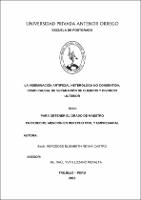Mostrar el registro sencillo del ítem
La inseminación artificial heteróloga no consentida, como causal de separación de cuerpos y divorcio ulterior
| dc.contributor.advisor | Lozano Peralta, Raúl Yvan | |
| dc.contributor.author | Reyna Castro, Mercedes Elisabeth | |
| dc.creator | Reyna Castro, Mercedes Elisabeth | |
| dc.date.accessioned | 2018-10-15T22:25:20Z | |
| dc.date.available | 2018-10-15T22:25:20Z | |
| dc.date.issued | 2018 | |
| dc.identifier.uri | https://hdl.handle.net/20.500.12759/4400 | |
| dc.description.abstract | La presente investigación, titulada “la inseminación artificial heteróloga no consentida, como causal de separación de cuerpos y divorcio ulterior”, radica en la necesidad de determinar si es conveniente incorporar al artículo 333º el Código Civil Peruano, este problema jurídico. El matrimonio en el Perù, es una instituciòn sumamente preservada, y tiene como fin proteger a la familia, por ellos las leyes que se dan en nuestro pais, se orientan a conservar un matrimonio armonioso, dando como ultima soluciòn el divorcio. Por ello el aticulo 234º del Codigo Civil Peruano, en la parte in fine señala “…El marido y la mujer tienen en el hogar autoridad, consideraciones, derechos, deberes y responsabilidades iguales”. Es así que, cuando se incumplen con los deberes del matrimonio se puede solicitar el divorcio. El tema de la presente investigación, radica en la posibilidad de determinar si se debe legislar acerca de este vacío legal, puesto que en caso que uno de los cónyuges, desee tener un hijo, utilizando las técnicas de inseminación artificial, en la clase heteròloga y no solicite el consentimiento a su pareja, afecta deberes del matrimonio, pues dicha decisión lo somete a una paternidad obligatoria y también puede la esposa tomar conocimiento de varios hijos extramatrimoniales, nacidos fruto de la donación de esperma del esposo. | es_PE |
| dc.description.abstract | The present investigation, entitled ““heterologous artificial insemination not consented as a cause of separation of bodies and subsequent divorce““, lies in the need to determine whether it is convenient to incorporate the Peruvian Civil Code, this legal problem, to article 333. Marriage in Peru, is a highly preserved institution, and aims to protect the family, by them the laws that are given in our country, are aimed at preserving a harmonious marriage, giving the last solution divorce. Therefore, article 234 of the Peruvian Civil Code, in the part in fine, states ““... Husbands and wives have equal authority, considerations, rights, duties and responsibilities in the home.““ Thus, when you breach the duties of marriage you can apply for a divorce. The subject of the present investigation, lies in the possibility of determining whether to legislate about this legal vacuum, since in case a woman unilaterally wishes to have a child, without informing her husband, he will be affected Of the duties of marriage, since that decision subjects him to accept paternity with all the legal assumptions that it infers. | en_US |
| dc.description.uri | Tesis | es_PE |
| dc.format | application/pdf | es_PE |
| dc.language.iso | spa | es_PE |
| dc.publisher | Universidad Privada Antenor Orrego - UPAO | es_PE |
| dc.relation.ispartofseries | T_MAEST.DERE_114 | |
| dc.rights | info:eu-repo/semantics/openAccess | es_PE |
| dc.source | Universidad Privada Antenor Orrego | es_PE |
| dc.source | Repositorio Institucional - UPAO | es_PE |
| dc.subject | Inseminación | es_PE |
| dc.subject | Cuerpos y divorcio | es_PE |
| dc.title | La inseminación artificial heteróloga no consentida, como causal de separación de cuerpos y divorcio ulterior | es_PE |
| dc.type | info:eu-repo/semantics/masterThesis | es_PE |
| thesis.degree.level | Maestría | es_PE |
| thesis.degree.grantor | Universidad Privada Antenor Orrego. Escuela de Postgrado | es_PE |
| thesis.degree.name | Maestro en Derecho con Mención en Derecho Civil y Empresarial | es_PE |
| thesis.degree.discipline | Maestría en Derecho | es_PE |

